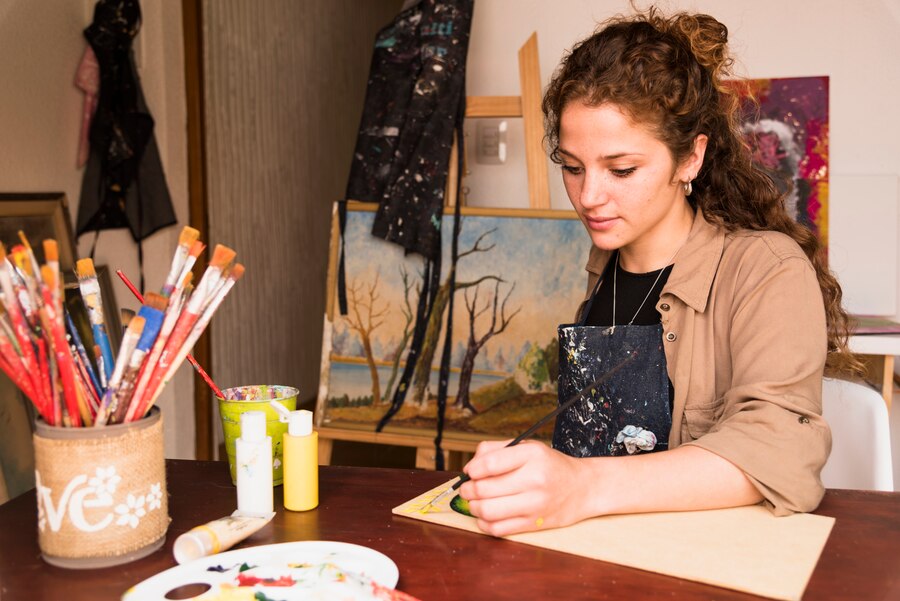
Are you ready to elevate your acrylic painting techniques? If you’ve mastered the basics and are eager to push your creative boundaries, these intermediate acrylic painting lessons will help you develop your unique artistic voice. Throughout this guide, we’ll explore advanced color theory, texture techniques, and composition strategies that will transform your artwork.
Understanding Advanced Color Theory in Acrylic Painting
Once you’ve grasped basic color mixing, it’s time to explore more nuanced approaches. First, experiment with limited color palettes to create cohesive compositions. Additionally, try working with complementary colors to create dynamic contrasts in your paintings. Furthermore, understanding temperature shifts can add emotional depth to your work.
Many intermediate artists struggle with achieving realistic skin tones. Therefore, practice mixing various flesh tones by combining primary colors with earth pigments. Subsequently, you’ll develop an intuitive understanding of how colors interact on canvas.
Mastering Texture Techniques with Acrylics
Acrylics offer incredible versatility when it comes to creating texture. Initially, try incorporating modeling paste to build dimensional surfaces. Then, experiment with gel mediums that can alter the consistency and finish of your paint. Meanwhile, don’t forget about glazing techniques that add luminosity to your work.
Here are some texture techniques to practice:
- Dry brushing for subtle highlights
- Palette knife application for bold impasto effects
- Sgraffito (scratching into wet paint) for line work
- Collage elements sealed with acrylic medium
Composition Strategies for More Effective Paintings
Strong composition transforms a good painting into a great one. First, practice the rule of thirds to create balanced layouts. Subsequently, experiment with unusual perspectives to add visual interest. In addition, use focal points to guide the viewer’s eye through your work.
Value studies are especially important for intermediate artists. Consequently, try creating thumbnail sketches focusing solely on light and dark patterns. Meanwhile, consider how negative space contributes to your composition. After all, what you don’t paint is often as important as what you do.
Developing Your Personal Style with Acrylics
As an intermediate artist, you’re likely seeking your unique creative voice. Therefore, study artists who inspire you, but avoid direct imitation. Instead, analyze what elements resonate with you and incorporate them thoughtfully. Moreover, keep a sketchbook to document ideas and experiments.
Many artists find that series work helps develop consistent techniques. Hence, try creating multiple paintings exploring a single theme or subject. Eventually, you’ll notice patterns emerging in your approach to color, texture, and composition.
Troubleshooting Common Intermediate Acrylic Painting Issues
Even experienced artists encounter challenges. For instance, muddy colors often result from over-mixing. To solve this problem, mix colors with intention and keep your palette organized. Likewise, addressing issues with uneven drying or unwanted texture marks requires adjusting your medium choices.
Acrylic paintings sometimes lack the depth of oils. However, you can overcome this limitation through careful layering and glazing. Furthermore, practice building translucent layers to create luminosity in your work. As a result, your paintings will develop a sophisticated quality that rivals other mediums.
Taking Your Skills Beyond the Studio
To truly grow as an intermediate artist, you must branch out beyond solitary practice. Consequently, consider joining critique groups where you can receive constructive feedback. Additionally, try participating in local exhibitions to gain exposure and build confidence.
Many intermediate artists find great value in specialized workshops. Therefore, seek out learning opportunities focused on specific techniques you wish to develop. Meanwhile, online communities can provide ongoing support and inspiration between formal lessons.
Remember, progress isn’t always linear. Nevertheless, consistent practice coupled with thoughtful experimentation will steadily improve your work. Above all, maintain curiosity and openness as you continue your artistic journey.
Are you ready to take your acrylic painting to the next level? Through dedicated practice and thoughtful exploration of these intermediate techniques, you’ll develop both technical skill and creative vision. Your artistic voice is waiting to emerge—grab your brushes and let it speak.
